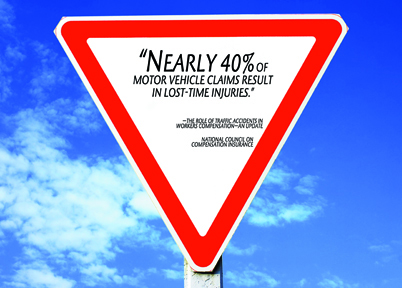 |
 |
 |
Traffic accident prevention: A central part of any safety program Vehicles account for a disproportionate level of high-severity claims
By Michael J. Moody, MBA, ARM A detailed analysis of any company's workers compensation experience can typically provide significant insight from a risk management point. Many times, organizations will use this data to develop proactive loss mitigation strategies for their workers compensation program. For the most part, corporations usually have a pretty good idea where their claims are coming from and thus develop specific loss control strategies around those types of losses. However, some exposures are not so easy to see, and unless the organization has had a loss or two in these areas, the exposure may go largely unnoticed. A recent update of an earlier study by the National Council on Compensation Insurance (NCCI) provides a perfect case in point. The study updates a similar, earlier report that they published in 2006 and has the title of "The Role of Traffic Accidents in Workers Compensation—An Update." It provides invaluable and, in some cases, unexpected data.
Not just for long-haul truckers Unfortunately, unless your firm is in the long-haul trucking or delivery services sectors, many organizations do not give much thought to traffic accidents. According to the latest information provided by the NCCI, this would be a mistake because even for companies that are not significantly involved with driving, it does represent a significant exposure. Among the issues that the study dealt with are the effects of recessions on driving accidents, leading factors that are linked to traffic accidents and the major job classifications that are involved in accidents. A 1996 Bureau of Labor Statistics study noted that about 40% of highway fatalities involved truck drivers. Other occupations included workers driving or riding to various locations to perform their work, for example, home health nurses, sales representatives, farm workers, police officers and other emergency service personnel. A similar result was also noted in the new NCCI study, except there was a slightly above average increase in both claims and losses in the large office and clerical class codes. The report notes that this group, office/clerical, is ranked second. One of the key issues that NCCI noted was the effects recessions are having on motor vehicle fatalities and injuries. At this point, they have significant data on this subject from 1966 through 2011 as reported by the National Highway Traffic Safety Administration. Over this period of time, the exposure to traffic accidents as measured by the number of vehicle miles travelled has more than tripled; however, during the most recent recession (12/07 to 5/09) the miles travelled declined by 2.5%. There were a number of reasons for this decline including higher unemployment, fewer truck shipments and changes in driving habits due to higher gas prices. It should be noted that this was the first real decline in vehicle miles travelled over the 45 years since 1966. The NCCI found that the numbers of fatalities, however, were more directly tied to cyclical recessionary periods. The total number of fatal crashes has declined over 37%, despite the fact that miles travelled having tripled for the years 1966 to 2011. While there are no specific reasons for this significant decline, NCCI speculates that it is a combination of advances in technology features such as antilock brakes, air bags and stability controls. Further, they note that changes in regulations governing road behavior such as seat belt and drunken driving laws may also account for reducing the number of fatalities. When they combined these numbers (fatalities and miles driven) to show the frequency per 100 million miles traveled, the average has declined by 80%, from 5.5 in 1996 to 1.1 in 2011. Declines during recessions were often steeper than the average reduction. Conventional wisdom would say that the frequency of fatalities would be higher for trucks than passenger vehicles; however, based on the NCCI data the frequency of fatalities is now similar for trucks and passenger vehicles.
Why care? Despite the fact that traffic accidents have been significantly reduced in recent years, the NCCI study found that "traffic accidents represented a growing share of workplace injuries." Additionally, "the share of nonfatal motor vehicle-related lost-time injuries increased about 35% since 1992." This is a meaningful number. But, a more troubling trend is that "workplace accidents that result in injuries to more than one worker are a special concern to employers." While this trend has been going down, the NCCI notes that motor vehicle accidents are more likely to result in multiple claims than any other cause of injury. NCCI stats indicate that 6% of motor vehicles result in multi-claim events, compared to 2.5% on average for all accident causes. There were a number of other important observations included in the NCCI study that should be taken into consideration in any loss mitigation program. Traffic accidents accounting for a disproportionate share of losses from multiple claims is not the only bad news. They also have a number of other disproportionate, negative claims characteristics. For example, these types of losses also have higher severity rates and are more likely to involve lost-time claims. In fact, "Nearly 40% of motor vehicle claims result in lost-time injuries." The total incurred severity for motor claims from multiple claim events is higher, $27,489 vs. $7,737 for other multiple-claims events. Additionally, for lost-time injuries motor vehicles claims are more likely to be permanent partial injuries or permanent total injuries than any other type of claims. The above numbers are just the tip of the iceberg. For example, "While motor vehicle claims comprise just over 2% of all claims, they comprise 7% of losses." Additionally, they account for one-third of all fatalities and over 13% of permanent total injuries. Further, the study says that, on average, "for temporary total injuries motor vehicle claims are 62% more costly than severity for all claims." The report also breaks down the types of injuries suffered in motor vehicle accidents. Not surprising, neck injuries is the leading diagnosis. Another finding that illustrates the scope of the problem is that motor vehicle claims, "on average, have longer duration than all other claims." Further, the average close rate for these types of losses is higher than average. Duration for open claims was 38% longer for motor vehicles claims vs. all claims 60 months old. Again not surprising, motor vehicle claims are much more likely to involve subrogation than the average claim. In general, about 1% of all claims have been subrogated at 60 months, but for motor vehicle losses, this rate balloons to 25%. Attorney involvement also increases sharply with motor vehicle accidents. "Overall, close to three times as many motor vehicle claims involve an attorney compared with all claims (14% vs. 5%)," notes the NCCI. The study also found several demographic differences that should be noted. For example, "higher-than-average percentage of motor vehicle claims occur in the 25-44 age group, and a lower-than-average occurs for 20-24 year olds." Older workers maintained average accident rates. These numbers are similar to the results of the prior study. Additionally motor vehicle accidents reflect a higher percentage of males. Finally, the report provides insight into the leading causes of traffic accidents. According to the report, as well as the National Highway Traffic Safety Administration, driver distraction is the leading cause of traffic accidents and near accidents. In this regard, the federal government recently established a Web site to assist employers in raising the awareness of and reducing distracted driving. The Web site points out that text messaging creates a much higher crash risk than other types of distracting activities. "Talking on a cell phone increases the risk of a crash four-fold," but texting creates a crash risk 23 times higher than driving while not distracted. On average, "a text message takes a driver's eyes off the road for 4.6 seconds," or in other words about the equivalent of traveling the length of a football field at 55 mph. The NCCI study makes it clear that employers should encourage safe driving practice, and make safe driving procedures a central part of any employee safety program.
|
|||||
| |||||
| ©The Rough Notes Company. No part of this publication may be reproduced, translated, stored in a database or retrieval system, or transmitted in any form by electronic, mechanical, photocopying, recording, or by other means, except as expressly permitted by the publisher. For permission contact Samuel W. Berman. |


